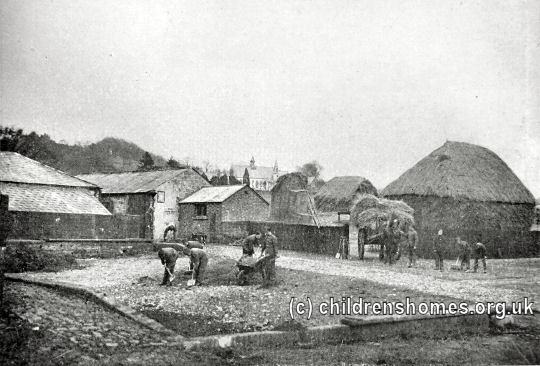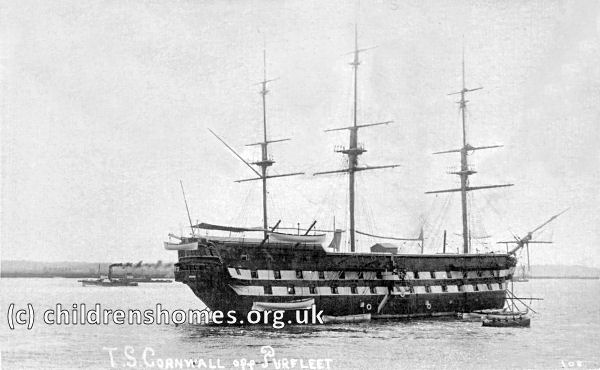Reformatory Schools
Attempts to provide care for children who had been involved in criminal or anti-social behaviour — those who in more recent times might be referred to as 'juvenile delinquents' — date back to at least the eighteenth century. An early initiative began in 1756 with the founding of the Marine Society "for the purpose of clothing landsmen and boys for the use of the king's ship, and as an expedient to provide for poor boys who might become a nuisance." The Society was a pioneer in the use of training ships for this work.
In 1788, the Philanthropic Society was set up "for the protection of poor children, and the offsprings of convicted felons; and for the reformation of those who have themselves been engaged in criminal practices." In the same year, the Society opened an institution at St George's Fields, Southwark, whose facilities included male and female 'Reforms'. The inmates manufactured items such as clothes, shoes, and rope, and were given religious instruction.

Philanthropic Society's 'Female Reform' and new chapel, c.1805. © Peter Higginbotham
In the first part of the nineteenth century, penalties for those found guilty of crimes would, by modern standards, be considered exceptionally severe. In 1833, a boy of 9 was sentenced to death (though not actually executed) for stealing 2d worth of paint. Two boys of 15 were transported for seven years for stealing a pair of boots. Such treatment began to be questioned and in 1837 Parkhurst prison was used to provide an experimental reformatory regime for young offenders. They were provided with outdoor industrial training, combined with school instruction and religious teaching. The establishment had mixed results and closed in 1864, with the authorities indicating that private or charitably run establishments were preferable for such purposes.
In 1846, Lord Houghton attempted to introduce a parliamentary bill to establish a reformatory schools system. Although the bill did not become law, it led to growing interest in such a scheme. The Philanthropic Society was again at the forefront of the movement. In 1849, after visiting the agricultural colony for delinquent boys at Mettray in France, the Society established a pioneering farm colony for boys at Redhill in Surrey.

Rickyard at Philanthropic Society's Farm School, Redhill, c.1920. © Peter Higginbotham
In 1851, the first conference on Preventive and Reformatory Schools was held in Birmingham, following which several new voluntary schools were established:
- Kingswood Reformatory at Bristol opened in 1852 by Mary Carpenter and Russell Scott.
- Saltley Reformatory founded in 1852 by Joseph Sturge and Charles Adderley (later Lord Norton).
- Stoke Farm Reformatory established in 1853 by Joseph Sturge.
The Reformatory School Act of 1854 enabled voluntary schools to be certified as efficient by the Inspector of Prisons. Convicted juvenile offenders, under the age of 16, could be granted a pardon on condition that they were committed to a Certified Reformatory School for a period of 2 to 5 years. Those entering reformatories were first required to spend a period of up to fourteen days in prison. Parents of inmates were required to contribute to the cost by a payment of up to 5s. per week. Also in 1854, the first girls' Reformatory School opened in Bristol.
There was campaign to remove the prison requirement for those entering reformatories by a group of magistrates, MPs, and social reformers such as Mary Carpenter. After this was unsuccessful, they proposed the creation of an alternative institution, the Certified Industrial School, aimed at a younger age group and without the prison element. The idea was taken up and resulted in the Industrial Schools Act of 1857.
In the wake of the 1854 and 1857 Acts, Reformatory and Industrial Schools were set up across the country, all of which had to be officially inspected and certified before they could begin operation. By 1875, there were 54 certified Reformatory Schools and 82 Industrial Schools in England and Wales. At the same date, Scotland had 12 Reformatories and 27 Industrial Schools. By 1885, there was a combined total of 61 Reformatories, 136 Industrial Schools, 9 Truant Schools, and 13 Day Industrial Schools. Generally schools took either just boys or girls, and some schools were specifically for Roman Catholic children.
Amongst the Reformatory Schools for boys were three naval training ships: the Clarence (for Roman Catholic boys) and the Akbar on the Mersey, and the Cornwall on the Thames.

The Cornwall, c.1910. © Peter Higginbotham
In 1899, the initial prison requirement for those entering a Reformatory was abolished. The difference between Reformatory Schools and Certified Industrial Schools was then diminished, although the latter broadly dealt with children who were younger and included those who were deemed to be in danger of becoming criminals rather than necessarily having committed offences.
Some reformatories had an associated Auxiliary Homes. These were usually small homes which either catered for particularly difficult cases, or were used as a half-way house for inmates who were about to leave to go into employment.
The majority of the both Reformatory and Industrial Schools were privately run, often by religious groups. For a variety of reasons, some proved unable to operate successfully and closed within a few years. For example, a Reformatory was opened in 1856 by the monks of St Bernard's Abbey at Whitwick in Leicestershire. The school, or 'agricultural colony' was took up to 250 delinquent Roman Catholic boys and was run with the help of lay assistants. However, the staff were unable to control their charges. There were several riots and in 1878 after sixty boys escaped, after attacking the master in charge with knives stolen from the dining room. The establishment was closed in 1881 after its certificate was withdrawn.

Arno's Court Reformatory for Girls, Bristol, c.1905. © Peter Higginbotham
The 1908 Children and Young Persons Act, sometimes referred to as the 'Children's Charter', carried out a major revision of the existing legislation relating to children and introduced a variety of measures for their legal protection. Parents who ill-treated or neglected their children could now be prosecuted. Foster parent now had be officially registered with their local authority. The Act also banned the sale cigarettes to children, their visiting pubs and pawnbrokers, and their employment in dangerous trades like the scrap metal industry.
Children who broke the law were now dealt with by special juvenile courts. However, the 1908 Act still maintained the distinction between Reformatory and Industrial Schools. Reformatory Schools continued to receive youthful offenders below the age of sixteen, while Industrial Schools received children under fourteen found to be destitute, begging or wandering the streets, or whose parents were deemed unfit to look after the them, or who associated with reputed thief or prostitute. The Act included a provision for children to be transferred between the two types of school. A period of probation, supervised by a probation officer, became available as an alternative to being sent to an Industrial School.
In October 1910, the weekly magazine John Bull published an account of the serious ill-treatment of boys at the Akbar Nautical Training School at Heswall. Former staff of School claimed that boys were gagged before being birched, that boys who were ill were caned as malingerers, that punishments included boys being drenched with cold water or being made to stand up all night for a trivial misdemeanour. It was further alleged that boys had died as a result of such punishments. A subsequent Home Office investigation by Under-Secretary C.F.G. Masterman rejected all the charges although found that there had been instances of "irregular punishments". John Bull stood its ground, calling Masterman's report a "white-washing" and claiming that staff at the school who had spoken out against its principle, Captain Beuttler, had been threatened by a Home Office Inspector. Eventually, Home Secretary Winston Churchill appointed a Departmental Committee to conduct a broad review of Reformatories and Industrial Schools.
Another press condemnation of Reformatories came in the shape of a series of six articles in the Daily Mail which claimed that they were "Schools for Crime". Amongst the Mail's allegations were that the boys lacked proper supervision, and were supervised by men who had no training in prison routine. The fact that the Reformatories and Industrial Schools were predominantly run by voluntary rather than state organisations was also criticised. (In 1911, none of the existing 37 Reformatories was run by a local authority, and only 22 of the 112 Industrial Schools.)
As a result of this bad press, committals to Reformatory and Industrial Schools declined steeply. In 1925, the Home Office set up a Departmental Committee to examine the future of the schools. Its report, issued in 1927, recommended that the distinction between Reformatory and Industrial Schools be abolished and replaced by a single type of establishment, to be known as an Approved School. The new Schools were to cater for all classes of neglected and delinquent children. This recommendation came into effect through the 1932 Children and Young Persons Act (slightly revised as part of the 1933 Children and Young Persons Act). Following the Act, many former Reformatory and Industrial schools converted to become Approved Schools.
Records
Since most Reformatories were privately run by charitable or religious groups, the survival of their records is rather uneven.
Most of those entering Reformatories were placed there by the courts and details of their committal recorded in magistrates' (Petty Sessions) records. These are generally found in the county or metropolitan archives of the place where the sentencing took place — this may be some distance from the institution where the young person subsequently became an inmate. It should be noted that some Reformatories also took voluntary admissions, whose details will not appear in court records.
A few Reformatories were run by national charities including Barnardo's, The National Children's Home and the Waifs and Strays Society and their records will form part of each organisation's archives. A similar situation applies to institutions of this type run by other bodies (e.g. religious groups) which still survive and which maintain their own archives. Access to such records may incur a charge and also be restricted to former inmates or their immediate descendants.
Otherwise, the best place to look for any surviving records for these institutions is the county or metropolitan record office covering the area.
Bibliography
- Carpenter, Mary Reformatory Schools, for the Children of the Perishing and Dangerous Classes, and for Juvenile Offenders (1851, General Books; various reprints available)
- Carlebach, Julius Caring for Children in Trouble (1970, Routledge & Kegan Paul)
- Higginbotham, Peter Children's Homes: A History of Institutional Care for Britain's Young (2017, Pen & Sword)
- Abel Smith, Doroth Crouchfield: A History of the Herts Training School 1857-1982 (2008, Able Publishing)
- Garnett, Emmeline Juvenile offenders in Victorian Lancashire: W J Garnnett and the Bleasdale Reformatory (2008, Regional Heritage Centre, Lancaster University)
- Hicks, J.D. The Yorkshire Catholic Reformatory, Market Weighton (1996, East Yorkshire Local History Society)
- Slocombe, Ivor Wiltshire Reformatory for Boys, Warminster, 1856-1924 (2005, Hobnob Press)
- Duckworth, J.S. The Hardwicke Reformatory School, Gloucestershire (in Transactions of the Bristol and Gloucestershire Archaeological Society, 1995, Vol. 113, 151-165)
- Higginbotham, Peter Children's Homes: A History of Institutional Care for Britain's Young (2017, Pen & Sword)
- Hyland,Jim Yesterday's Answers: Yesterday's Answers: Development and Decline of Schools for Young Offenders (1993, Whiting and Birch)
- Millham, S, Bullock, R, and Cherrett, P After Grace — Teeth: a comparative study of the residential experience of boys in Approved Schools (1975, Chaucer Publishing)
Links
- None identified at present.
Except where indicated, this page () © Peter Higginbotham. Contents may not be reproduced without permission.


